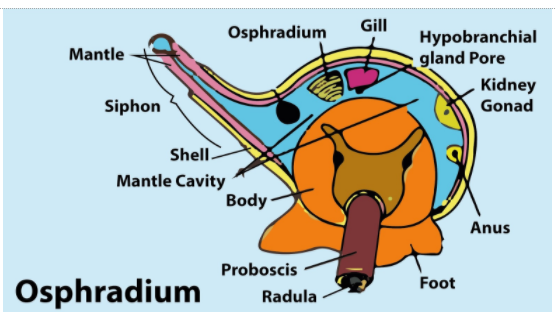
Chemoreceptor in Pila is
(a)Ctenidium
(b)Radula
(c)Osphradium
(d)All of the above
Answer
480.9k+ views
Hint: It is found in some of the molluscs as an olfactory receptor and may also act as a respiratory organ that helps in recognizing the water and the nutrients which are free of impurities.
Complete answer:
The osphradium is the chemoreceptor which is found in Pila. It detects whether the water has silt and other chemicals present in it or not and tests the suitable food particles that enter the body.
Additional Information:
-The chemoreceptors are the sensory receptors that send signals when coming in contact with certain chemical stimuli.
-The process of chemoreception helps in detecting the type of habits, food, mates, and predators.
-These chemoreceptors are generally found in the head region or the air passage and mouth region.
-The presence of osphradium is certain mollusks are their characteristic feature.
-It is the sensory organ of the Pila which regulates the movement of the water current which goes inside its mantle cavity.
-Pila is the genus that belongs to the phylum Mollusca.
-The phylum Mollusca is the second-largest phylum among the invertebrates.
-The three main features of the phylum Mollusca are the presence of the mantle cavity, radial, and nervous system.
-The mantle cavity is the outer shell which is responsible for the prices of respiration and excretion.
-The shell is made up of cellulose and chitin in most of the mollusks.

So, the correct answer is, ‘Osphradium.’
Note: The word Mollusca was derived from the French word mollusque, which was itself derived from the Latin word Mollis, meaning ‘soft’. Malacology is the study of the mollusks. The radula is the feeding organ of the mollusks which sometimes act as a tongue. The respiratory organ in the case of mollusks is known as ctenidium which may be in the form of gills.
Complete answer:
The osphradium is the chemoreceptor which is found in Pila. It detects whether the water has silt and other chemicals present in it or not and tests the suitable food particles that enter the body.
Additional Information:
-The chemoreceptors are the sensory receptors that send signals when coming in contact with certain chemical stimuli.
-The process of chemoreception helps in detecting the type of habits, food, mates, and predators.
-These chemoreceptors are generally found in the head region or the air passage and mouth region.
-The presence of osphradium is certain mollusks are their characteristic feature.
-It is the sensory organ of the Pila which regulates the movement of the water current which goes inside its mantle cavity.
-Pila is the genus that belongs to the phylum Mollusca.
-The phylum Mollusca is the second-largest phylum among the invertebrates.
-The three main features of the phylum Mollusca are the presence of the mantle cavity, radial, and nervous system.
-The mantle cavity is the outer shell which is responsible for the prices of respiration and excretion.
-The shell is made up of cellulose and chitin in most of the mollusks.

So, the correct answer is, ‘Osphradium.’
Note: The word Mollusca was derived from the French word mollusque, which was itself derived from the Latin word Mollis, meaning ‘soft’. Malacology is the study of the mollusks. The radula is the feeding organ of the mollusks which sometimes act as a tongue. The respiratory organ in the case of mollusks is known as ctenidium which may be in the form of gills.
Recently Updated Pages
Glucose when reduced with HI and red Phosphorus gives class 11 chemistry CBSE

The highest possible oxidation states of Uranium and class 11 chemistry CBSE

Find the value of x if the mode of the following data class 11 maths CBSE

Which of the following can be used in the Friedel Crafts class 11 chemistry CBSE

A sphere of mass 40 kg is attracted by a second sphere class 11 physics CBSE

Statement I Reactivity of aluminium decreases when class 11 chemistry CBSE

Trending doubts
10 examples of friction in our daily life

The correct order of melting point of 14th group elements class 11 chemistry CBSE

Difference Between Prokaryotic Cells and Eukaryotic Cells

One Metric ton is equal to kg A 10000 B 1000 C 100 class 11 physics CBSE

What is the specific heat capacity of ice water and class 11 physics CBSE

State and prove Bernoullis theorem class 11 physics CBSE




